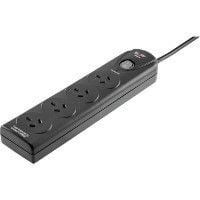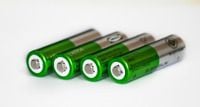)
A surge protector is a device that shields computer and other electronic devices and appliances from surges in electrical power or a transient voltage that flows from the power supply. Standard Australian voltage for home and office buildings is 240 volts, any voltage over this is considered transient and can damage electronic devices and appliances that are connected to an outlet.
Even though power surges are so brief that they are measured in nanoseconds, they can cause considerable damage to equipment that may be connected to mains power.
A surge protector works by channelling the extra voltage into the outlet's grounding wire, thus preventing it from flowing through the electronic device or appliance while at the same time allowing the normal voltage to continue along its path.
Electrical surges can particularly damage computer equipment by 'frying' the internal components like the motherboard or even the hard drive.
It is a common misunderstanding that surge protectors will protect electronic and electrical appliances from lightning, the most familiar source of power surges.
Even the most effective surge protectors cannot protect equipment from the sudden increase in electrical pressure of millions of volts that lightning can supply.
Probably the best way to prevent damage during a severe electrical storm is to unplug devices that could be seriously damaged.
Surge protectors more commonly protect equipment from lower-voltage surges that occur frequently in modern electrical wiring.
For example, devices such as refrigerators and air conditioners require large amounts of energy to switch motors and compressors on and off, creating surges in power that disrupt the steady flow of voltage.
Faulty wiring, downed power lines and faulty equipment at the power source, the electricity provider itself, can all cause power surges as well.
For those of you interested in the technical side of what happens during surge protection, here is a summary of what happens.
Most surge protectors operate with the help of a Metal Oxide Varistor, or MOV. Inside a surge protecting power strip or adapter, the MOV is the link between the surge protector's hot wire and its grounding wire.
The MOV has a variable electrical resistance, which means it can make adjustments to incoming voltage that is either too low or too high. When it's too high, as in an electrical surge, the MOV redirects only the excess voltage into the grounding wire, where it can dissipate safely. The safe level of voltage continues to flow through, ensuring uninterrupted use of your electronics and appliances.
The short answer YES - where it makes sense to do so.
However, this does not mean you need to connect ALL your appliances to a surge protector, for example, a desk lamp may not be connected, however, your computers, TV and media centres and any other sensitive and expensive equipment most definitely needs to be connected to a surge protector.
It's the simplest and most cost effective 'insurance' for your electrical and electronic equipment.
The important question is not 'do I need surge protection', rather, how do you choose the right surge protection device?
It can be difficult finding the right surge protector for your needs there are many to choose from ranging from cheap to very expensive. What makes a surge protector good? And why are some surge protectors much more expensive than others? Are there any features you should be looking out for?
Read on!
Here are some important characteristics of a good surge protector, at the very least, you need to ensure the following;
Indicator Lights
Surge protectors only have a limited lifespan depending on how often they are put to work. Even when the surge protector properly diverts a surge so your electronics aren't damaged, the protector itself can be damaged in the process. One of the most important features then is an indicator light. An indicator light will let you know that your surge protector is working fine. Is the indicator light not working? Time to buy a new surge protector.
UL Rating
As for protection power, good surge protectors will come with a UL rating, a rating by the independent Underwriters Laboratories that tests the safety of electronic devices. Don't bother with a surge protector that doesn't have a UL rating.
Clamping Voltage
The clamping voltage is the level at which the surge protector starts redirecting the excess electricity away from the plugged-in devices. In other words, a surge protector with a lower clamping voltage will trigger earlier, thus better protecting your devices.
Response Time
The response time is how long it takes for the surge protector to detect a surge in electricity. The lower value, the faster the response. This reduces the time that your plugged-in devices are exposed to the surge. Ideally, you'll want a surge protector with a response time of 1 nanosecond or faster.
On the down side though, surge protectors are probably one of the biggest causes of RCD tripping. That being the case, my recommendation would be to limit the use of surge protectors to high value/expensive electronic equipment.
For more information on the right surge protection for your office or home, contact Simon Caddy Electrical today by calling 0400 110081.
We service the Upper North Shore area including Hornsby, Wahroonga, Pymble, Turramurra, Killara, Lindfield, Roseville, Chatswood down to North Sydney.
| Tags:Electrical SafetySmart Devices |
)
| Posted in:Electrical SafetyElectrical Services |
)
| Posted in:Electrical ServicesBatteries & Battery Techonology |
)
| Posted in:EnvironmentalElectrical HazardsElectrical Waste |
)
| Posted in:Electrical ServicesData & Cabling |
